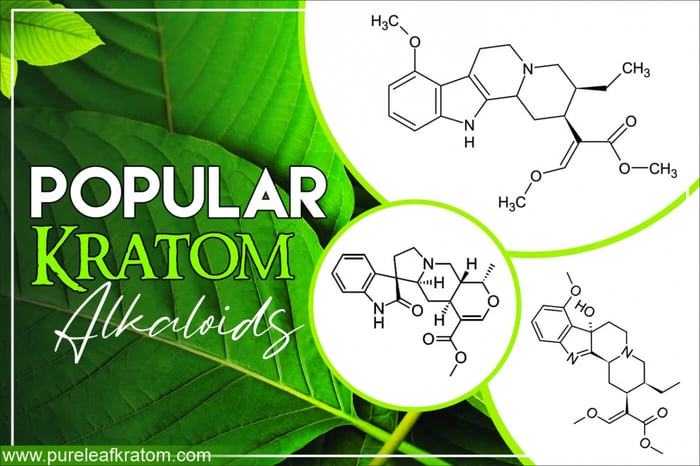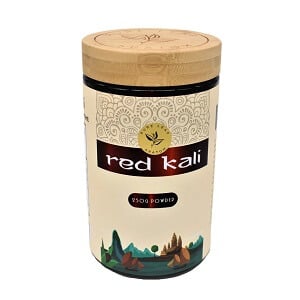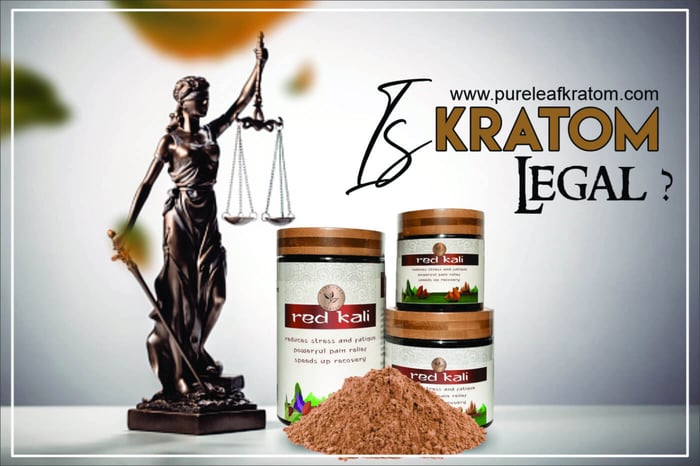- Announcements
- Features
- Kratom Buying Guide
- References
- Reviews
- Tips
- Kratom
- Kava
- Delta
- Mushrooms
- Knowledge

List Of Kratom Alkaloids & Their Role? Perfectionist’s Guide
 Asad Khan
Kratom Buying Guide
Asad Khan
Kratom Buying Guide
10/14/2022 11:16pm
8 minute read
Regular Mitragyna users are much more familiar with the potency of Kratom alkaloids. But are you familiar with a long list of those alkaloids? Give a better read to understand the influencing behavior of alkaloids in Kratom.
What Are Kratom Alkaloids?
Alkaloids are photochemical compounds found in plants. Mitragyna Speciosa also possesses a wide range of these chemical compounds, influencing its activity. Depending upon the concentration of Kratom alkaloids, they showcase a variety of effects on your body.
What Role Do Kratom Alkaloids Play?
There are more than 40 alkaloids found in Mitragyna Speciosa. When you consume this herb, its alkaloids play a vital role in its activity. The flavor, sharpness, bitterness, and influencing behavior that you experience are due to the presence of these alkaloids.
Do Kratom Strains Differ In Alkaloid Content?
Three strains of Mitragyna, red, white, and green strain, are popular around the world. They differ from one another based on the concentration of alkaloids present. Red strain is highly potent than the two. It has a greater concentration of alkaloids, mainly 7-hydroxy Mitragynine and Mitragynine.
White and green strains have a lesser amount of Kratom alkaloids compared to their red alternative. Thus they are less potent. Potency depends on the alkaloids’ concentration in Mitragyna.
A higher concentration of alkaloids leads to more potency, sharpness, and bitterness. New users mostly like to ingest Speciosa strains with relatively low potency.

Click Here To Buy Premium Quality Red Kali Kratom Capsules Online
List Of Popular Kratom Alkaloids
The world is full of everything. All we need is to look for it. The same goes for Korth. The word Kratom was known for this because of its habitat. Every unique thing has to pass through some hurdles to achieve the best among the others. Kratom is a natural product that passes through specific weather. Kratom's unique properties are the result of the climate effects on the plant. There are quite a lot types of alkaloids present in Kratom. Some are listed below.
7-Hydroxy Mitragynine
7-hydroxy Mitragynine is the active metabolite of Mitragynine that lessens the anodyne influences. It makes up only 2% of total Kratom alkaloids. Its concentration varies with strains. Red vein strains of Mitragyna carry a higher amount of this alkaloid. Formerly, people used to utilize the greeneries of the Mitragyna plant to minimize their bitter feelings and one-of-its-kind behavior. People from Southeast Asia who were immune to using Kratom had a positive outcome. According to the users, it has the least half-life of a few hours, thus showing rapid results.
Mitragynine
Mitragynine is a potent alkaloid. It is found chiefly in the Korth, called Mitragyna Speciosa, around 64% to 66%. Its concentration varies in different strains depending on certain factor parameters, including but not limited to climatic conditions and the harvesting process. Mitragynine and 7-hydroxy Mitragynine both are the primary alkaloids for Kratom.
The difference between them is their influence on the body’s system. Mitragynine concentration is higher in the two green and white strains than in the red vein. Also, it has a lower amount in the Malaysian Mitragyna strains.
Others
There are many alkaloids of Kratom apart from Mitragynine and 7-hydroxy mitragynine. These unique alkaloids are also found in other species. However, there is a need to conduct more research to establish valuable claims.
● Paynantheine
It is the second amplest alkaloid, and only a limited amount of data is gathered regarding this alkaloid than others. As per that little knowledge, Paynantheine is present around only 8.6% to 9% of the total content of alkaloids.
● Speciogynine
As per the gathered and limited command of the alkaloids present, Speciogynine is said to be the third amplest alkaloid found in Mitragyna.
● Mitraphylline
It is an oxindole derivative found in higher concentrations in the leaves of a cat’s claw. It contains carbomethoxyl fas, a functional group that, upon hydrolysis, forms mitraphyllic acid. Spectroscopy studies show the presence of two chromophores in mitraphylline, responsible for its characteristic features.
● Isomitraphylline
Isomitraphylline is one of the highly potent oxindole alkaloids found in Uncaria Tomentosa. Its concentration varies in different species and strains. Uncaria has cultivated the south American side and belongs to the Rubiaceae family.
● Speciophylline
Speciophylline is another potent oxindole alkaloid of cat’s claw, Cephalanthus tetrandrous, and other species. Its potency is based on its concentration which varies from plant to plant.
● Rhynchophylline
Rhynchophylline is similar to Mitragynine in its chemical structure. It is also found in Uncaria Tomentosa. Besides, rhynchophylline alkaloid is present in the leaves of Mitragyna Speciosa and Uncaria rhynchophylla. It has a variety of traditional uses.
● Ajmalicine
It is also called Raubasine and is in specific concentrations in devil peppers and bright eyes. Ajmaciline is found in small amounts in Mitragyna Speciosa and Catharanthus Roseus. It has several vital activities in the body.
● Ciliaphylline
Ciliaphylline is another one of the potent alkaloids of Mitragyna Speciosa. It is obtained from the Korth plant's young twigs and stem bark. Due to its incredibly lesser concentration, little or no research is done regarding its activity.
● Corynantheidine
Corynantheine or Rauhimbine alkaloid is present in Rauvolfia and Corynanthe plants. It is a diastereomers of yohimbine and rauwolscine. It resembles Ajmalicine. Corynantheine has 30-fold higher activity than its parent compounds.
● Corynoxeine
Corynoxeine is also found in multiple strains of Uncaria Tomentosa and Mitragyna Speciosa. It varies with different strains concerning its concentration and potency.
● Corynoxine A and B
These two are the derivatives or analogs of Corynoxine. They have the exact origin that is Mitargyna Speciosa and Uncaria Tomentosa. These plants are widely cultivated in Southeast Asian countries like Indonesia, Thailand, and Malaysia.
● Epicatechin
This alkaloid is found in dark chocolate, catechin, green tea, and grapes. Epicatechin belongs to the polyphenols subcategory called flavonoids. It gives contrasting aromas, thus used in the food and perfume industries.
● 9-Hydroxycorynanthedine
It is an analog of Mitragynine, an indole Korth alkaloid. Regular users of Kratom experienced positive results from this alkaloid. Also, it possesses less than 1% of total alkaloids. This lesser percentage reflects the least possible drastic impacts on the system.
● Isomitrafoline
Isomitrfoline is the most newer alkaloid found in Mitragyna Speciosa. It is present much less than any other alkaloid component; therefore, no research has yet been done on this Korth alkaloid.
● Isoteropodine
It is a pentacyclic oxindole alkaloid of Uncaria Tomentosa. It has a molecular weight of 368.4 a.m.u with no stereochemistry research. Furthermore, it possesses unspecified optical activity.
● Mitraversine
This alkaloid is derived from the sister plant of Korth, Mitragyna Parvifolia. It resembles Mitragynine in structure but is less potent due to a minimum concentration of less than 1%.

Click Here To Buy Premium Quality Red Kali Kratom Powder Online
Final Words On Kratom Alkaloids
The concentration of Kratom alkaloids varies from one strain to another. There are over 40 alkaloids found in this botanical, including 7-hydroxy Mitragynine and Mitragynine. All are discussed above deeply. Don’t miss this read.
Based on these alkaloids, Kratom strains are divided into different colors, e.g., red, green, white and gold veins. Some consist of higher concentrations, whereas others come with low alkaloid contents.
Do you wonder how to purchase Mitragyna locally? Well, simply search online for Kratom near me, and you will find a couple of nearby vendors to purchase from.
Frequently Asked Questions
Q1. Can we make Kratom tea?
Yes. People prepare Kratom tea by dissolving crushed Kratom powder in warm water for a couple of minutes and straining it out. You can add lemon or apple cider vinegar keeping your taste preferences in mind.
Q2. Can we encapsulate the Kratom alkaloids?
Yes. It is a convenient method for newbies to use Kratom. It is available in cellulose-based and gelatin capsules which mask the bitter taste and sharpness of Speciosa.
Q3. How long do Kratom capsules take to kick in the body?
When you ingest Korth capsules, they take a couple of minutes to release the potent alkaloids. The release time highly depends on the design and formulation of these capsules.
Related Articles

Kratom is Legal In The United States? Kratom Legality By State
7 minute read
10/14/2022 11:48pm

What Are Strongest Kratom Capsules? A Complete Guide For You!
6 minute read
10/13/2022 4:20am

What Is Trainwreck Kratom? A Complete Guide!
7 minute read
10/13/2022 3:54am
